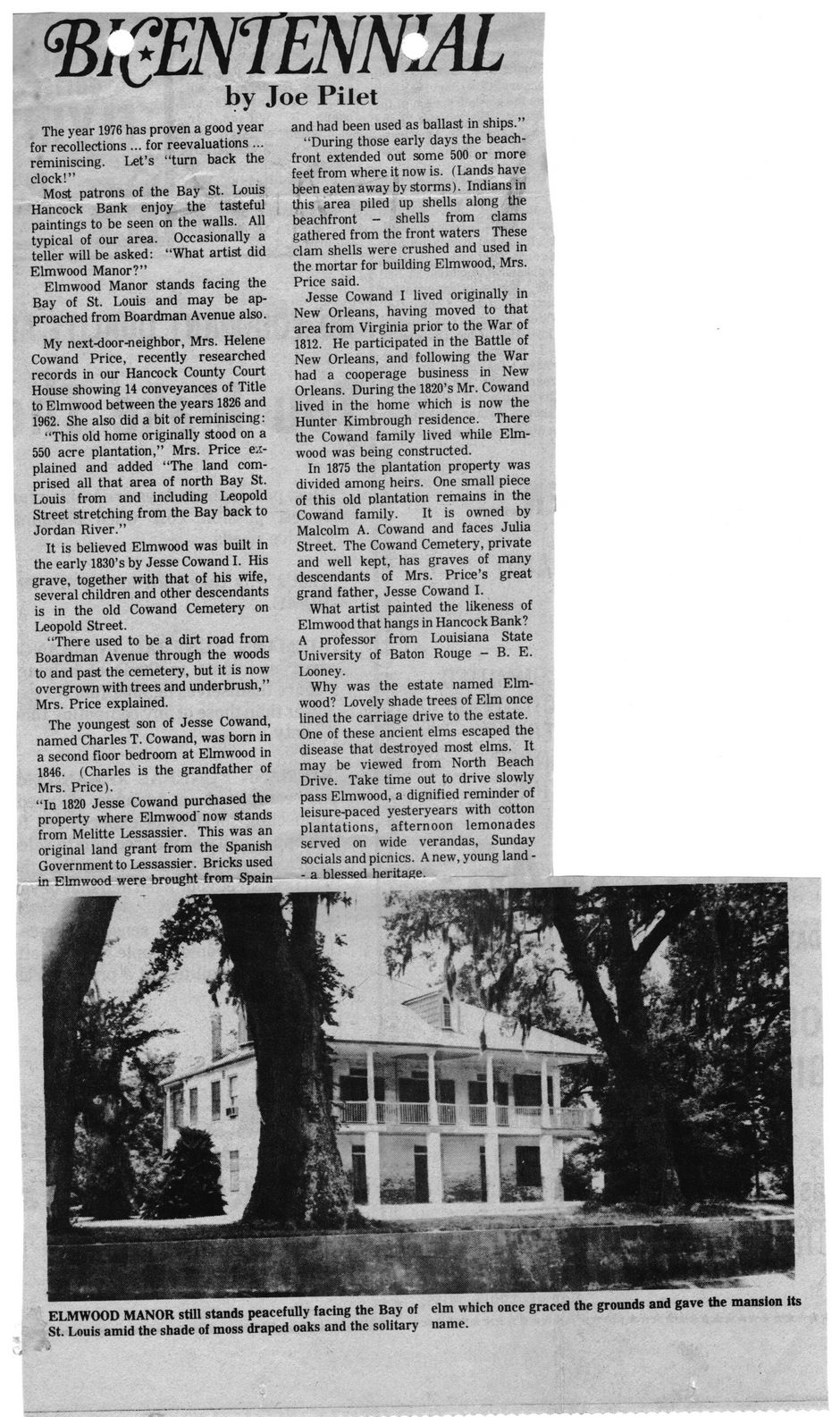This text was obtained via automated optical character recognition.
It has not been edited and may therefore contain several errors.
%'eENTENNIAL by Joe Pilet The year 1976 has proven a good year for recollections ... for reevaluations ... reminiscing. Let’s “turn back the clock!” Most patrons of the Bay St. Louis Hancock Bank enjoy the tasteful paintings to be seen on the walls. All typical of our area. Occasionally a teller will be asked: “What artist did Elmwood Manor?” Elmwood Manor stands facing the Bay of St. Louis and may be approached from Boardman Avenue also. My next-door-neighbor, Mrs. Helene Cowand Price, recently researched records in our Hancock County Court House showing 14 conveyances of Title to Elmwood between the years 1826 and 1962. She also did a bit of reminiscing: “This old home originally stood on a 550 acre plantation,” Mrs. Price explained and added “The land comprised all that area of north Bay St. Louis from and including Leopold Street stretching from the Bay back to Jordan River.” It is believed Elmwood was built in the early 1830’s by Jesse Cowand I. His grave, together with that of his wife, several children and other descendants is in the old Cowand Cemetery on Leopold Street. “There used to be a dirt road from Boardman Avenue through the woods to and past the cemetery, but it is now overgrown with trees and underbrush,” Mrs. Price explained. The youngest son of Jesse Co wand, named Charles T. Cowand, was born in a second floor bedroom at Elmwood in 1846. (Charles is the grandfather of Mrs. Price). “In 1820 Jesse Cowand purchased the property where Elmwood'now stands from Melitte Lessassier. This was an original land grant from the Spanish Government to Lessassier. Bricks used in Elmwood were brought from Spain and had been used as ballast in ships.” “During those early days the beachfront extended out some 500 or more feet from where it now is. (Lands have been eaten away by storms). Indians in this area piled up shells along the beachfront - shells from clams gathered from the front waters These clam shells were crushed and used in the mortar for building Elmwood, Mrs. Price said. Jesse Cowand I lived originally in New Orleans, having moved to that area from Virginia prior to the War of 1812. He participated in the Battle of New Orleans, and following the War had a cooperage business in New Orleans. During the 1820’s Mr. Cowand lived in the home which is now the Hunter Kimbrough residence. There the Cowand family lived while Elmwood was being constructed. In 1875 the plantation property was divided among heirs. One small piece of this old plantation remains in the Cowand family. It is owned by Malcolm A. Cowand and faces Julia Street. The Cowand Cemetery, private and well kept, has graves of many descendants of Mrs. Price’s great grand father, Jesse Cowand I. What artist painted the likeness of Elmwood that hangs in Hancock Bank? A professor from Louisiana State University of Baton Rouge - B. E. Looney. Why was the estate named Elmwood? Lovely shade trees of Elm once lined the carriage drive to the estate. One of these ancient elms escaped the disease that destroyed most elms. It may be viewed from North Beach Drive. Take time out to drive slowly pass Elmwood, a dignified reminder of leisure-paced yesteryears with cotton plantations, afternoon lemonades served on wide verandas, Sunday socials and picnics. A new, young land - - a blessed heritage. ELMWOOD MANOR still stands peacefully facing the Bay of elm which once graced the grounds and gave the mansion its St. Louis amid the shade of moss draped oaks and the solitary name.

Elmwood Plantation Document-(43)